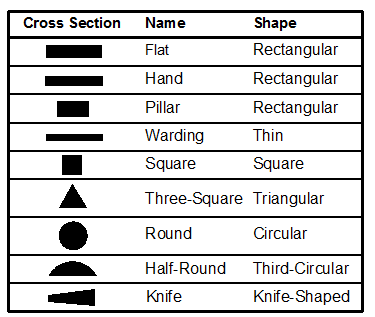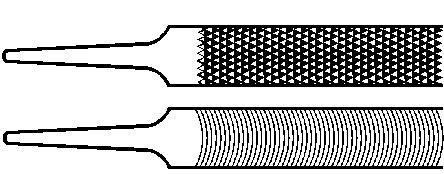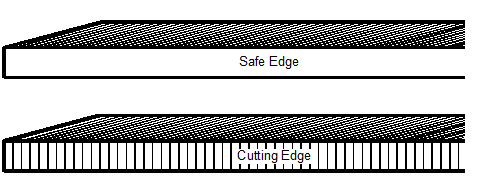- Acknowledgements
- Introduction
- Chapter 1: Measurement Tools, Layout & Job Planning
- Chapter 2: Basic Hand Tools
- Chapter 3: Filing & Sawing
- Chapter 4: Grinding, Reaming, Broaching & Lapping
- Chapter 5: Drills & Drilling Operations
- Chapter 6: Threads & Threading
- Chapter 7: Turning Operations
- Chapter 8: Milling Operations
- Chapter 9: Fastening Methods
- Chapter 10: Why Steel Hardens
- Chapter 11: Safety & Good Shop Practices
- Chapter 12: Other Shop Know-how
- Appendix I: Sharpening Steel Lathe Tools
- Appendix II: Surface Speed Table & Cutting Tool Selector Chart
- Appendix III: Decimal Equivalents of Fractional, Letter & Metric Drills
- Glossary
- Index
Chapter 3
Filing & Sawing
The ability to focus attention on important things is a defining characteristic of intelligence.
—Robert J. Shiller
Section I – Filing
Introduction
Crude files were used since 1100 years bc in the form of stones with ridges running at right angles across them. Like modern files, they were used to sharpen tool edges. The first attempt to make files by machine began in 1490, but the first successful production began in France about 1750. Hammers, cold chisels, and punches are blacksmiths’ tools adopted by machinists, but files are the machinists’ first and most basic tool. Before the development of machine tools, files were the only way to cut and shape metals precisely. With skill and patience, early machinists made clocks and locks with files, usually out of brass. Because there are faster methods of metal removal today, files are mainly used to sharpen, smooth edges, remove burrs, or make small adjustments, but they remain an important and handy tool. In some third-world countries today, copies of modern firearms are still made using files. Files have the advantages of being inexpensive, portable, able to get into tight spots, and require no electric power.
File Nomenclature
What are the parts of a file?
See Figure 3–1.

Figure 3–1. Parts of a file.
File Characteristics
What characteristics distinguish one file from another?
There are many, including:
- Length for most files lies between 4 and 14 inches. The most common lengths are 4, 6, 8, and 12 inches. File length is measured from the heel to the point and does not include the handle length, except for jewelers’ files where the handle length is included.
- Cross sectional shape often makes a file more suitable for a specific task. For example, flat files should be used for general-purpose work, a square file for enlarging rectangular holes, and a round file for enlarging round holes. A half-round file can be used for dual purposes: the flat surface for filing flat surfaces, and the half-round one for grooves. Figure 3–2 shows some common file cross sections.

Figure 3–2. File cross sections.
- Figure 3–3 shows four file shapes especially useful for making or enlarging grooves.

Figure 3–3. Files for making grooves.
- Type of teeth
- Single-cut files have one row of parallel teeth diagonally along their face. With relatively light pressure, they produce a smooth finish on hard materials, see Figure 3–4 (top).
- Double-cut files have two intersecting rows of teeth which produce fast stock removal and good clearing of chips, but leave a coarse surface. Heavy cutting pressure is often used. See Figure 3–4 (bottom).

Figure 3–4. Single-cut (top) and double-cut file teeth (bottom).
- Rasp-tooth files, Figure 3–5 (top), have a series of individual rounded teeth raised from the surface of the file blank by a sharp narrow, punch-like cutting tool. They are used for soft materials like wood, leather, and lead, where fast material removal is needed. Heavy cutting pressure may be used.
- Curved-tooth files, Figure 3–5 (bottom), work well on softer materials like lead, aluminum, brass, copper, plastics, wood, die cast zinc, auto body fillers, and hard rubber. This tooth design tends to resist pinning, filling the teeth with filed particles.

Figure 3–5. Files with special purpose teeth: rasp-tooth file
(top) and curved-tooth file (bottom).
- Coarseness is the number of teeth per inch of file length, Figure 3–6. Both single- and double-cut files are manufactured in various degrees of coarseness, Table 3–1. No particular number of teeth represents a degree of coarseness because the number of teeth for a given coarseness is proportional to the length of the file. Varying degrees of coarseness are comparable only when files of the same length and shape are considered.

Figure 3–6. File coarseness: coarse to smooth (left to right).
|
Single Cut |
Double Cut |
|
Rough |
— |
|
Coarse |
Coarse |
|
Bastard |
Bastard |
|
Second Cut |
Second Cut |
|
Smooth |
Smooth |
|
— |
Dead or Super Smooth |
Table 3–1. File coarseness.
- Tooth angle on most files runs between 65° and 85° to the file’s length. Most files have a 65° angle.
- Edge design, Figure 3–7, with and without a safe edge. Safe edges allow the face of the file to cut while the edge does not. It is a good idea to run a stone along the safe edges of files the first time they are used to insure that the edges are smooth.

Figure 3–7. Files with and without a safe edge.

